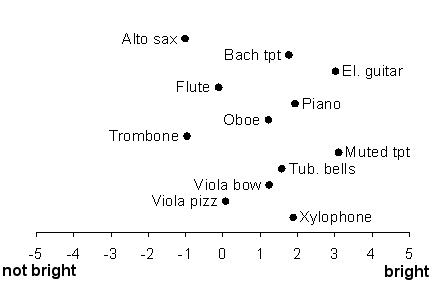[ Lay Language Paper Index | Press Room ]
Music Synthesis for the Terrified:
Using Everyday Words to Control Synthesizers
Alastair Disley - acd500@york.ac.uk
David Howard & Andy Hunt
Audio Lab, Department of Electronics, The University of York
York, United Kingdom YO10 5DD
Popular version of paper 3aPP12
Presented Wednesday morning, June 7th, 2006
151st ASA Meeting, Providence, RI
Current electronic musical synthesizers allow almost any sound imaginable to be created. However, creating and controlling those sounds is highly complex, requiring specialists' knowledge of both the synthesis process and the acoustic properties of the desired sound. This technical language typically talks about sound in terms of frequencies, amplitudes, envelopes, and filters.
When a conductor or musician describes changes in their sound timbre, they typically use adjectives such as bright, harsh, and warm. We are developing a synthesizer that will have controllers labeled with such adjectives, so that the creation and control of new sounds is intuitive to performing musicians.

Will future synthesisers have controls like these?
Before we could create such a synthesizer, we needed to better understand which timbral adjectives musicians used, how those adjectives related to sound parameters we could measure, and whether all musicians even agreed on definitions of different words.
We asked 59 British musicians to listen to a number of different instrumental sounds, and rate them on a number of scales labeled with adjectives, such as bright to not bright. We chose the words based on previous studies and our own survey of musicians. The diagram below shows average listener answers rating how bright twelve different instruments were. The Harmon-muted trumpet, a sound often used by Miles Davis, was rated the brightest sound, but the sample we used of an alto saxophone was thought least bright.

Not surprisingly, for some words (such as metallic and wooden) we found distinct disagreement on their meaning. Some adjectives however, including bright, warm and dull, showed good agreement between our listeners, and by looking at the sounds rated highest and lowest for each word we were able to match some of them with particular sound features.
This relationship between the timbral adjectives and sound timbre provides the basis on which we will implement a synthesizer in practice. Musicians will be able to create different sound timbres by moving sliders labeled with the everyday words they use to describe sound instead of the complex synthesis parameters currently in use.
[ Lay Language Paper Index | Press Room ]